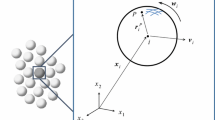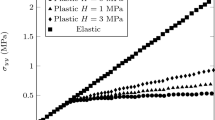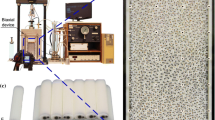Abstract
In discrete element method simulations for industrial applications, long, flat, bendable particles are often approximated as rods with circular cross sections. However, such crude approximation of the particle geometry raises questions on the ability to reproduce the material bulk properties. Therefore, we describe a novel discrete element representation of flexible, flat, thin particles, consisting of a triangulated mass-spring model of the particle’s neutral plane, with the thickness of the particle incorporated in customised contact models. We validate the model with experiments of packing after gravitational deposition and sinusoidal excitation, where we show that the model correctly predicts the packing density for long, flexible, flat particles. Furthermore, we benchmark the model against a circular cross-sectional flexible rod model. Investigation of the dynamics of densification under vibrational compaction shows that the Kohlrausch–Williams–Watts stretched exponential law is well suited to describe the compaction dynamics of the described particles. The novel foil model provides insights in the bulk behaviour of flexible flat particles, otherwise difficult or even impossible to obtain theoretically or experimentally for random orientations. Applications of the model could include the modelling of fabrics, biological material like leaves, soft plastic, and paper.












Similar content being viewed by others
References
Baraff D, Witkin A (1998) Large steps in cloth simulation. In: Proceedings of the 25th Annual Conference on computer graphics and interactive techniques, SIGGRAPH ’98. Association for computing machinery, New York, NY, USA, pp 43–54
Benjamini Y, Hochberg Y (1995) Controlling the false discovery rate: A practical and powerful approach to multiple testing. Journal of the Royal Statistical Society. Series B (Methodological) 57(1):289–300
Cleary PW (2010) DEM prediction of industrial and geophysical particle flows. Particuology 8(2):106–118
Cundall PA, Strack OD (1979) A discrete numerical model for granular assemblies. Geotechnique 29(1):47–65
Diels E, Odenthal T, Keresztes J, Vanmaercke S, Verboven P, Nicolai B, Saeys W, Ramon H, Smeets B (2016) Development of a visco-elastoplastic contact force model and its parameter determination for apples. Postharvest Biology and Technology 120:157–166
Diels E, Wang Z, Nicolai B, Ramon H, Smeets B (2019) Discrete element modelling of tomato tissue deformation and failure at the cellular scale. Soft Matter 15(16):3362–3378
Džiugys A, Peters B (2001) A new approach to detect the contact of two dimensional elliptical particles. International Journal for Numerical and Analytical Methods in Geomechanics 25(15):1487–1500
Engineering ToolBox: Metals and alloys, densities. www.engineeringtoolbox.com/metal-alloys-densities-d_50.html (2004 - accessed 25 January 2021)
Gay Neto, A., Pimenta, P.M., Wriggers, P.: A master-surface to master-surface formulation for beam to beam contact. Part I: frictionless interaction. Computer methods in applied mechanics and engineering 303, 400–429 (2016)
Gusev AA, Hine PJ, Ward IM (2000) Fiber packing and elastic properties of a transversely random unidirectional glass/epoxy composite. Composites science and technology 60(4):535–541
Hestenes MR, Stiefel E (1952) Methods of conjugate gradients for solving linear systems. Journal of Research of the National Bureau of Standards 49:409–435
Kemper S, Lang T, Frerichs L (2014) Der überlagerte Schnitt im Scheibenmähwerk Ergebnisse aus Feldversuchen und Simulation [The overlapping cut in the disc mower - results from from field tests and simulation]. Landtechnik 69(4):171–175
Ketterhagen WR, Am Ende MT, Hancock BC (2009) Process modeling in the pharmaceutical industry using the discrete element method. Journal of Pharmaceutical Sciences 98(2):442–470
Kuwabara G, Kono K (1987) Restitution coefficient in a collision between two spheres. Japanese J Appl Phy 26(Part 1, No. 8): 1230–1233
Langston P, Kennedy AR, Constantin H (2015) Discrete element modelling of flexible fibre packing. Comput Mat Sci 96(Part A): 108–116
Leblicq T, Smeets B, Ramon H, Saeys W (2016) A discrete element approach for modelling the compression of crop stems. Computers and Electronics in Agriculture 123:80–88
Leblicq T, Vanmaercke S, Ramon H, Saeys W (2015) Discrete element modelling of bendable tubes. International Journal of Mechanical Sciences 94–95:75
Lu G, Third JR, Müller CR (2015) Discrete element models for non-spherical particle systems: From theoretical developments to applications. Chemical Engineering Science 127:425–465
Markauskas D, Kruggel-Emden H, Scherer V (2018) Numerical analysis of wet plastic particle separation using a coupled DEM-SPH method. Powder technology 325:218–227
Mcdowell G, Li H (2016) Discrete element modelling of scaled railway ballast under triaxial conditions. Granular Matter 18(3):1–10
Mpacts: Mpacts simulation software. (accessed 22 February 2021)
Nicolas M, Mathonnet JE, Dalloz B, Sornay P (2017) Granular compaction and stretched exponentials - Experiments and a numerical stochastic model. EPJ Web of Conferences 140:8001
O’Sullivan C (2011) Particle-based discrete element modeling: Geomechanics Perspective. International Journal of Geomechanics 11(6):449–464
Parkhouse JG, Kelly A (1995) The random packing of fibres in three dimensions. Proceedings of the Royal Society of London. SeriesA: Mathematical and Physical Sciences 451(1943): 737–746
Philippe P, Bideau D (2002) Compaction dynamics of a granular medium under vertical tapping. Europhysics Letters 60(5):677–683
Pieczywek PM, Zdunek A (2017) Compression simulations of plant tissue in 3D using a mass-spring system approach and discrete element method. Soft Matter 13(40):7318–7331
Richard P, Nicodemi M, Delannay R, Ribière P, Bideau D (2005) Slow relaxation and compaction of granular systems. Nature Materials 4(2):121–128
Smeets B, Odenthal T, Keresztes J, Vanmaercke S, Van Liedekerke P, Tijskens E, Saeys W, Van Oosterwyck H, Ramon H (2014) Modeling contact interactions between triangulated rounded bodies for the discrete element method. Computer Methods in Applied Mechanics and Engineering 277:219–238
Smeets B, Odenthal T, Vanmaercke S, Ramon H (2015) Polygon-based contact description for modeling arbitrary polyhedra in the discrete element method. Computer Methods in Applied Mechanics and Engineering 290:277–289
Soliman S, Sant S, Nichol JW, Khabiry M, Traversa E, Khademhosseini A (2011) Controlling the porosity of fibrous scaffolds by modulating the fiber diameter and packing density. Journal of Biomedical Materials Research. Part A 96A(3):566–574
Tijskens E, Ramon H, Baerdemaeker J (2003) Discrete element modelling for process simulation in agriculture. Journal of Sound and Vibration 266(3):493–514
Toll S (1998) Packing mechanics of fiber reinforcements. Polymer Engineering and Science 38(8):1337–1350
Vandewalle N, Lumay G, Gerasimov O, Ludewig F (2007) The influence of grain shape, friction and cohesion on granular compaction dynamics. European Physical Journal E 22(3):241–248
Villarruel FX, Lauderdale BE, Mueth DM, Jaeger HM (2000) Compaction of rods: relaxation and ordering in vibrated, anisotropic granular material. Physical Review E – Statistical Physics, Plasmas, Fluids, and Related Interdisciplinary Topics 61(6B), 6914–6921
Wachs A, Girolami L, Vinay G, Ferrer G (2012) Grains3D, a flexible DEM approach for particles of arbitrary convex shape Part I: Numerical model and validations. Powder technology 224:374–389
Wriggers P, Zavarise G (1997) On contact between three-dimensional beams undergoing large deflections. Communications in numerical methods in engineering 13(6):429–438
Acknowledgements
M.L. is an SB PhD fellow at Research Foundation Flanders (FWO) with grant 1S67917N. B.S. acknowledges support from the Research Foundation Flanders (FWO) grant 12Z6118N, and KU Leuven internal funding C14/18/055. The funders had no role in study design, data collection and analysis, decision to publish, or preparation of the manuscript.
Author information
Authors and Affiliations
Corresponding author
Ethics declarations
Conflict of interest
The authors declare that they have no conflict of interest.
Additional information
Publisher's Note
Springer Nature remains neutral with regard to jurisdictional claims in published maps and institutional affiliations.
Supplementary Information
Below is the link to the electronic supplementary material.
Rights and permissions
About this article
Cite this article
Mathias, L., Wouter, S., Tom, L. et al. Packing simulation of thin flexible particles using a novel discrete element model. Comp. Part. Mech. 9, 407–420 (2022). https://doi.org/10.1007/s40571-021-00419-9
Received:
Revised:
Accepted:
Published:
Issue Date:
DOI: https://doi.org/10.1007/s40571-021-00419-9




